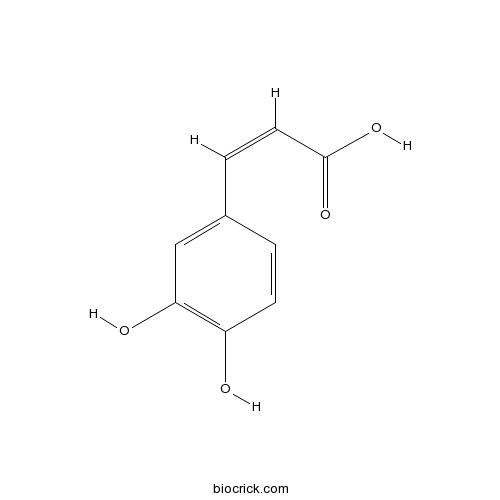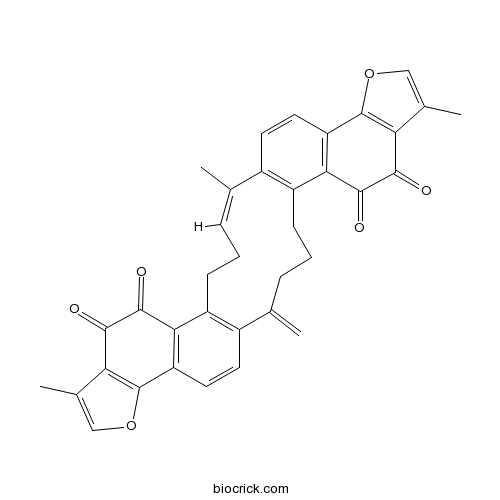Salvia przewalskii
Salvia przewalskii
1. The products in our compound library are selected from thousands of unique natural products; 2. It has the characteristics of diverse structure, diverse sources and wide coverage of activities; 3. Provide information on the activity of products from major journals, patents and research reports around the world, providing theoretical direction and research basis for further research and screening; 4. Free combination according to the type, source, target and disease of natural product; 5. The compound powder is placed in a covered tube and then discharged into a 10 x 10 cryostat; 6. Transport in ice pack or dry ice pack. Please store it at -20 °C as soon as possible after receiving the product, and use it as soon as possible after opening.
Natural products/compounds from Salvia przewalskii
- Cat.No. Product Name CAS Number COA
-
BCN5893
Rosmarinic acid20283-92-5
Instructions

-
BCN5979
Caffeic acid331-39-5
Instructions

-
BCN5304
Cryptotanshinone35825-57-1
Instructions

-
BCX1035
Isoferulic Acid537-73-5
Instructions

-
BCN4169
Neoprzewaquinone A630057-39-5
Instructions

-
BCN4373
Ethyl gallate831-61-8
Instructions

-
BCN2823
Dimethyl lithospermate B875313-64-7
Instructions

Identification of Salvia species using high-performance liquid chromatography combined with chemical pattern recognition analysis.[Pubmed: 29105962]
Salvia miltiorrhiza, also known as Danshen, is a widely used traditional Chinese medicine for the treatment of cardiovascular diseases and hematological abnormalities. The root and rhizome of Salvia przewalskii and Salvia yunnanensis have been found as substitutes for Salvia miltiorrhiza in the market. In this study, the chemical information of 14 major compounds in Salvia miltiorrhiza and its substitutes were determined using a high-performance liquid chromatography method. Stepwise discriminant analysis was adopted to select the characteristic variables. Partial least squares discriminant and hierarchical cluster analysis were performed to classify Salvia miltiorrhiza and its substitutes. The results showed that all of the samples were correctly classified both in partial least squares discriminant analysis and hierarchical cluster analysis based on the four compounds (caffeic acid, rosmarinic acid, salvianolic acid B, and salvianolic acid A). This method can not only distinguish Salvia miltiorrhiza and its substitutes, but also classify Salvia przewalskii and Salvia yunnanensis. The method can be applied for the quality assessment of Salvia miltiorrhiza and identification of unknown samples.
The effects of Salvia przewalskii total phenolic acid extract on immune complex glomerulonephritis.[Pubmed: 29025319]
Salvia przewalskii Maxim. (Lamiaceae) is a Chinese herbal medicine that has long been used for the treatment of cardiovascular disease.
Nectar replenishment maintains the neutral effects of nectar robbing on female reproductive success of Salvia przewalskii (Lamiaceae), a plant pollinated and robbed by bumble bees.[Pubmed: 28158409]
It has been suggested that the dynamics of nectar replenishment could differ for flowers after being nectar robbed or visited legitimately, but further experimental work is needed to investigate this hypothesis. This study aimed to assess the role of nectar replenishment in mediating the effects of nectar robbing on pollinator behaviour and plant reproduction.
Antioxidative Stress Effects of Salvia przewalskii Extract in Experimentally Injured Podocytes.[Pubmed: 27529846]
Oxidative stress is a leading cause of puromycin aminonucleoside (PAN)-induced nephrosis. As the inhibition of oxidative stress may improve injury of podocyte, we aimed at examining the effect of total phenolic acid extract of Salvia przewalskii (SPE) on PAN-induced oxidative stress in vivo and in vitro.
[Chemical Constituents from Salvia przewalskii Root].[Pubmed: 26762059]
To study the chemical constituents of the root of Salvia przewalakii.
Protective Effect of Salvia Przewalskii Extract on Puromycin-Induced Podocyte Injury.[Pubmed: 26439819]
To determine the effect of Salvia przewalskii extract (SPE) from total phenolic acids on puromycin aminonucleoside (PAN)-induced rat podocyte injury.
Salviprzols A and B, C₂₁- and C₂₂-terpenoids from the roots of Salvia przewalskii Maxim.[Pubmed: 25301774]
Two C₂₁- and C₂₂-terpenoids, salviprzols A (1) and B (2), together with 24 known compounds including 17 diterpenoids (3-19), a triterpenoid (20), and 6 phenolic derivatives (21-26), were isolated from the roots of Salvia przewalskii Maxim. Salviprzols A and B represented a new subtype of C₂₃-terpenoids featured by an additional 2-oxopropyl moiety at C-12 and a rare γ-hydroxyl-α-methyl-α,β-unsaturated-γ-lactone ring system. Their structures were elucidated by extensive spectroscopic analyses, and the structure of 2 was confirmed by a single-crystal X-ray diffraction crystallography. The cytotoxic activities of the new isolates were tested. A plausible biosynthetic pathway for 1 and 2 was also proposed.


